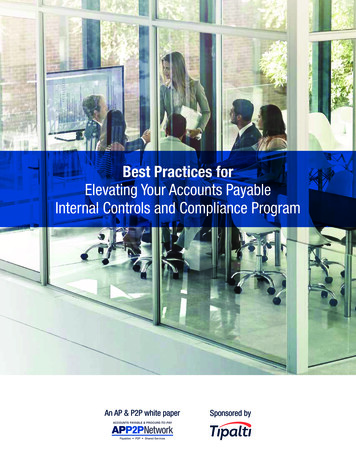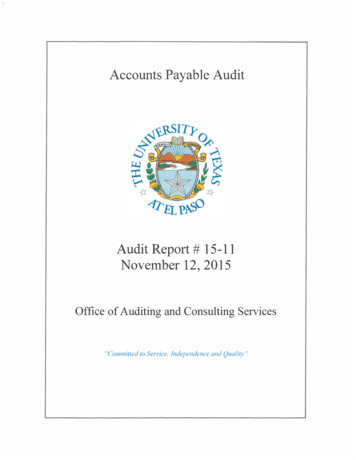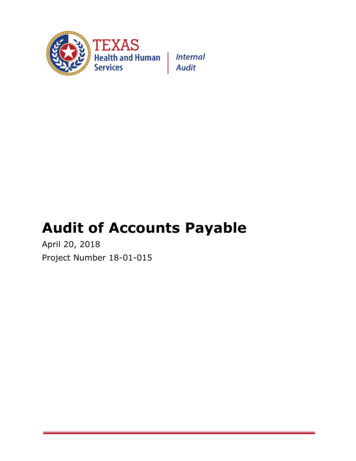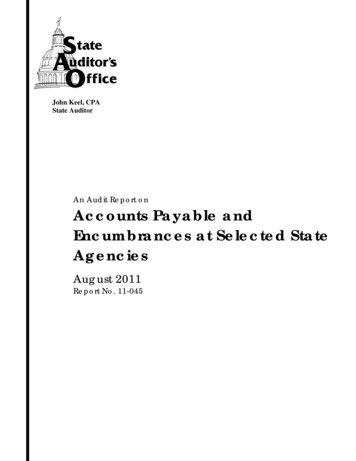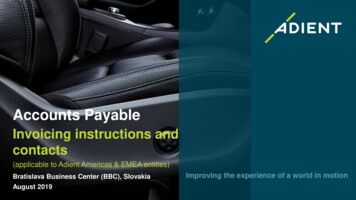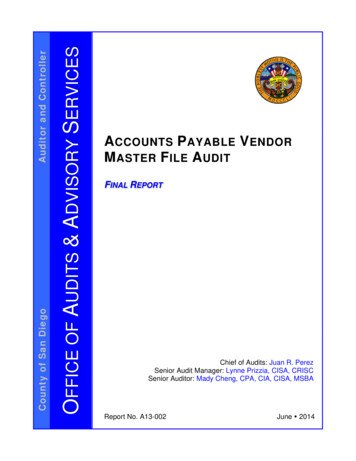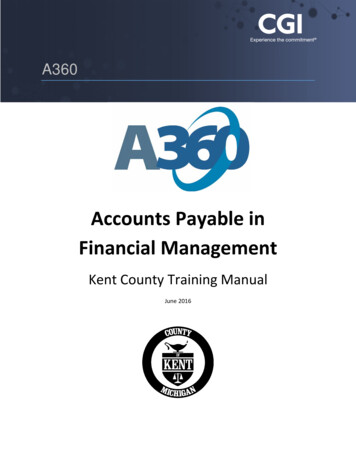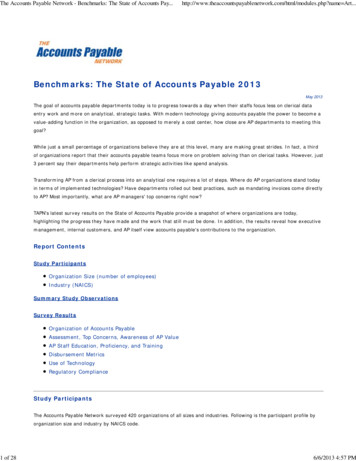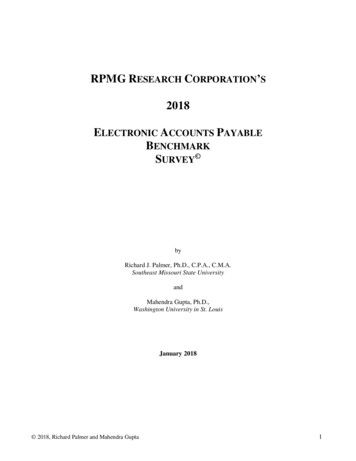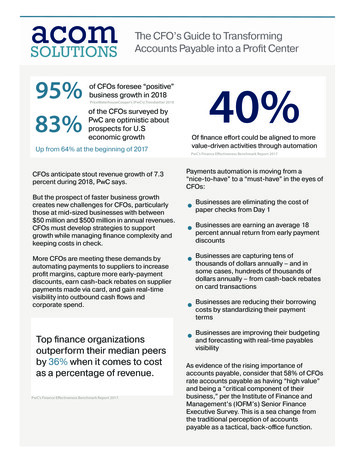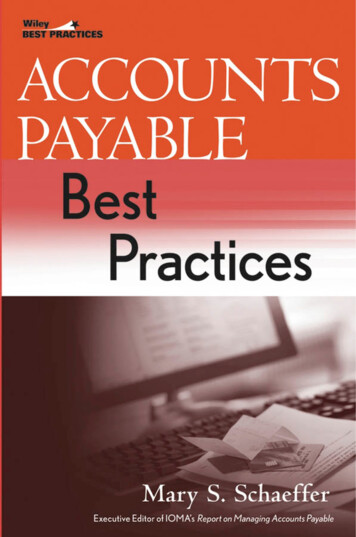
Transcription
Accounts PayableBest Practices
Accounts PayableBest PracticesMary S. SchaefferExecutive EditorIOMA’s Report on Managing Accounts PayableCo-creatorThe Accounts Payable Certification ProgramsJohn Wiley & Sons, Inc.
This book is printed on acid-free paper.Copyright 2004 by Mary S. Schaeffer and the Institute of Managementand Administration, New York, NY. All rights reserved.Published by John Wiley & Sons, Inc., Hoboken, New JerseyPublished simultaneously in CanadaNo part of this publication may be reproduced, stored in a retrieval system, ortransmitted in any form or by any means, electronic, mechanical, photocopying,recording, scanning, or otherwise, except as permitted under Section 107 or 108of the 1976 United States Copyright Act, without either the prior writtenpermission of the Publisher, or authorization through payment of the appropriateper-copy fee to the Copyright Clearance Center, Inc., 222 Rosewood Drive,Danvers, MA 01923, 978-750-8400, fax 978-646-8600, or on the Web atwww.copyright.com. Requests to the Publisher for permission should be addressedto the Permissions Department, John Wiley & Sons, Inc., 111 River Street,Hoboken, NJ 07030, 201-748-6011, fax 201-748-6008.Limit of Liability/Disclaimer of Warranty: While the publisher and author haveused their best efforts in preparing this book, they make no representations orwarranties with respect to the accuracy or completeness of the contents of thisbook and specifically disclaim any implied warranties of merchantability or fitnessfor a particular purpose. No warranty may be created or extended by salesrepresentatives or written sales materials. The advice and strategies containedherein may not be suitable for your situation. You should consult with aprofessional where appropriate. Neither the publisher nor author shall be liablefor any loss of profit or any other commercial damages, including but not limitedto special, incidental, consequential, or other damages.For general information on our other products and services, or technical support,please contact our Customer Care Department within the United States at 800762-2974, outside the United States at 317-572-3993 or fax 317-572-4002.Wiley also publishes its books in a variety of electronic formats. Some content thatappears in print may not be available in electronic books.For more information about Wiley products, visit our Web site at www.wiley.com.Library of Congress Cataloging-in-Publication Data:Schaeffer, Mary S.Accounts payable best practices / Mary S. Schaeffer.p. cm.“Published simultaneously in Canada.”Includes index.ISBN 0-471-63695-9 (cloth : alk. paper)1. Accounts payable. I. Title.HF5681.A27 S3 2004658.15′26—dc222003026689Printed in the United States of America10 9 8 7 6 5 4 3 2 1
For my candle in the wind,my father,Ron Schacht
ContentsIntroductionChapter 1Chapter 2xiInvoicesInvoice Handling: ApprovalsForwarding InvoicesVerifying Invoice DataInvoice-Coding StandardsShort-Paying InvoicesPaying Small-Dollar InvoicesHandling Unidentified InvoicesHandling Invoices without InvoiceNumbersCase Study: How One Pro Took AccountsPayable Out of the Picture whenResolving Customer DiscrepanciesChecksCheck PrintingCheck SigningCheck Stock StorageDistribution of ChecksCheck Fraudvii1168111619212325292935404245
ContentsChapter 3Chapter 4Chapter 5Rush or Emergency ChecksCase Study: Information Sheet:Segregation of Duties50OperationalDuplicate Payment AvoidancePaying When the Original InvoiceIs MissingLimiting Calls to Accounts PayablePetty CashSupplier StatementsCase Study: Expert DemonstratesHow to Put the Web to Workfor Accounts Payable5757Master Vendor FileMaster Vendor File SetupUsing Naming ConventionsMaking Changes to the Master Vendor FileMaster Vendor File CleanupCase Study: Experienced AccountsPayable Pro Shares Master VendorFile Control SecretsP-CardsDesign of the P-Card ProgramEstablishing ProceduresSetting ControlsIncreasing Usage1099s and P-CardsTermsRebatesCase Study: P-Cards Improve AccountsPayable Process at PETsMART,Rock-Tenn, and 8110111
ContentsChapter 6Travel and EntertainmentFormal PolicyCash AdvancesT&E Report FormVerifying DataHandling ReceiptsReservationsReimbursing EmployeesUnused TicketsCase Study: Making the Most of DirectDepositCase Study: TransUnion’s SuccessfulLow-Tech, Low-Budget T&E SolutionCase Study: Follow IBM’s Lead: 21Steps to an Award-WinningT&E ProcessCase Study: How Zurich AmericaDeveloped Its Own ElectronicT&E er 7Regulatory Issues1511099s151Sales and Use Tax154Unclaimed Property156Case Study: How to Avoid Salesand Use Tax Audit Disasters159Case Study: A Typical Company’s UnclaimedProperty Experience162Chapter 8Cash ManagementTaking Early Payment DiscountsPayment Status Information for VendorsBank Accounts and FraudOther Cash Management–RelatedInitiativesix167167170172174
ContentsCase Study: General Electric’s Approachto Electronic Invoicing and PaymentProcessingChapter 9Chapter 10TechnologyImaging and WorkflowThe InternetE-InvoicingCase Study: PPL Electric Offers Lessonson Setting Up an Accounts PayableImaging SolutionCase Study: An Accounts PayableWeb SiteCase Study: How the Accounts PayableManager at Merck OverhauledDepartment Proceduresand TechnologyCommunications/Customer RelationsPayment Status Information for VendorsCommunicating Relevant Informationto VendorsCommunicating with Internal CustomersImproving the Procure-to-Pay CycleCase Study: Interactive Voice ResponseFrees Accounts Payable from Annoying“Where’s My Money” CallsCase Study: How Automated AccountsPayable and Purchasing SystemsMesh at 9222229x
IntroductionCompanies should be interested in implementing best practices in their accounts payable (AP) operations for the samereason that Willy Sutton focused on banks—it’s where themoney is. The fundamental structure of the AP function isthat it is about a company’s financial integrity. Those who disregard their AP operations will adversely affect their bottomline, either directly by Paying invoices more than once Paying charges that should have been borne by the supplier Failing to take advantage of special pricing arrangements Not taking earned discounts Being fined by states for failing to comply with escheator sales and tax rulesor indirectly through Increased transactional costsIncreased costs to resolve discrepanciesIncreased costs to fix errorsIncreased costs by failing to take advantage of newprocesses and technologies Failing to earn early payment discountsxi
IntroductionOVERVIEW: FACTORSThe AP function has changed radically over the last 10 years,and it appears that the transformation will continue at leastfor the foreseeable future. The following are some of the factors affecting this transformation: Check fraud had reached levels that demanded not onlya change in the way companies write checks but also thetechnology used to limit the scams. Companies looking for ways to keep costs under controlhave cut AP staffs to the bone. Technology has made a big dent in the amount of resources companies now need to allocate to transactionalwork. The concentration in a growing number of accountspayable operations is shifting from transactional processing to an analytical focus. The overall number of people working in AP is declining. That decrease is almost entirely in the clerical staff.Consequently, the professional level of these departments is rising. States, desperate for ways to increase their coffers without alienating the voters, have found companies failingto comply with unclaimed property and sales and usetax rules to be just the answer to their problems. Theyare aggressively pursuing them and, when they findthem in noncompliance, auditing and fining them uncompromisingly. States now use third-party auditors inmany cases. They also work together. The accounting scandals and the enactment of the Sarbanes-Oxley Act have raised the level of inspection atmany companies, both private and public. The Internetxii
IntroductionBEST PRACTICE PRINCIPLESWith reduced resources and increased scrutiny, implementingbest practices in AP is more crucial than ever. Strictly focusingon cost is apt to get a company into trouble. While keepingcosts down is a good idea, it is important not to let that be theonly consideration. It is important that sufficient thought alsobe given to adequate controls, fraud prevention, and goodvendor relationships.To that end, in defining best practices, the following overriding principles will govern: Up-front controlsA move toward minimizing paperClear and easily traceable audit trailsMinimal clerical data entryTransactional efficiencyThis should translate into lower costs, in most instances.BEST PRACTICES IN A THEORETICAL BESTPRACTICE COMPANYIf it were possible to select best practices simply on the basisof what’s best and not taking into account corporate culture,existing procedures, financial limitations, and unique corporate procedures, here’s what the list might look like: Implement e-invoicing for all invoicing. Use positive pay. Insist that all purchase orders be completely filled outbefore they are issued, and that Receiving completelycheck packing slips. Use workflow to route invoices for reviews with an escalating approval structure.xiii
Introduction Have travel and entertainment (T&E) reports completed electronically; spot check rather than completelyreview each report; and make all employee reimbursements using direct deposit. Comply with all escheat and sales and use tax regulations. Make every payment possible electronically. Encourage all employees to be paid via direct deposit. Take advantage of all early payment discounts, but don’tmake any payments before the due date. Provide adequate resources for employee continuingeducation opportunities.IMPLEMENTING BEST ACCOUNTS PAYABLEPRACTICE POLICIESWhile the rest of this book examines AP functions in detailand spells out the best practices for each, this section will lookat some overall best practice policies: Minimize or eliminate low-dollar invoices. This can bedone through a variety of techniques, including:Use of purchase cards (p-cards)Making payments to certain vendors from statementsrather than invoicesE-invoicing Institute strong up-front controls, eliminating the mostback-end approval processes:Completely filled-out purchase ordersEvaluated receipt settlementNegative assurance Get rid of as much paper as possible using:Imaging䢇䢇䢇䢇䢇䢇䢇xiv
IntroductionE-invoicingA firm policy regarding where invoices should be sentfirstP-cardsConsider outsourcing specialty functions, including:Sales and use taxEscheatDuplicate payment auditsValue-added tax reclaimTelecom and freight payment and auditsMake as many payments as possible electronically, using:Direct depositAutomated clearinghouse credits and, where appropriate, debitsLimit the number of phone calls coming into AP by:Using online dispute resolutionUpdating payment status on the InternetUpdating payment status using interactive voice response (IVR)Publicizing payment timetablesIncluding an explanation slip with all short paymentsDon’t forget the value employees bring to the AP function:Motivate staffFocus on moraleAllocate some resources for staff education䢇䢇䢇 䢇䢇䢇䢇䢇 䢇䢇 䢇䢇䢇䢇䢇 䢇䢇䢇A WORD ABOUT BEST PRACTICESIt’s fine to talk about best practices in a theoretical sense, butprofessionals who toil in the field know that sometimes whatworks in theory will not work in their organization. Somexv
Introductiontimes industry peculiarities stand in the way, and other timesit might be the corporate culture or practices in another department. If the receiving dock does not do a good job atchecking packing slips, it is pointless to implement a processthat relies on accurate information from Receiving.Thus, in this book, you will see discussions of best practices as well as what we refer to as “almost best practices.”These take into account that not all practices will work at allcompanies and offer an alternative to those who cannot implement the absolutely best practices.We also include a discussion of those practices that definitely should not be used but, as many reading this knowfrom painful experience, are in use in parts of CorporateAmerica. Hopefully, by seeing these practices identified inprint, some will decide to replace them in their own organizations.WHAT’S INSIDEThe book starts at the beginning, reviewing the way invoicesare processed. It identifies a number of potential problem areas and then offers best practice solutions. Some of the itemsmay seem mundane to those not intimately familiar with AP.However, if they are ignored, expect duplicate payments andperhaps even fraud to increase.At least for the present, as most AP departments have notmade the leap to 100 percent electronic payments, checksdominate the payment landscape. If all aspects of this function are not handled properly, check fraud, duplicate payments, and processing costs will all increase. Also, the company may put itself in the position of being completely liablefor any check fraud that does occur.The mundane operational aspects of AP are reviewed in away that focuses attention on issues that are sometimes ignored. A complete chapter follows this on one of the most imxvi
Introductionportant, yet overlooked aspects of the purchase-to-pay cycle—the master vendor file. You would be surprised how often themaster vendor file is not even an issue on the table—with disastrous consequences. With the renewed interest in internalaudit and controls, thanks to the Sarbanes-Oxley Act, companies disregard their master vendor file at their own peril.P-cards are one of the easiest innovations to understand,and companies everywhere are adopting them. The potentialfor growth in this area is staggering. Thus, it is imperative thatthose who use them do so correctly. T
Design of the P-Card Program 97 Establishing Procedures 99 Setting Controls 101 Increasing Usage 105 1099s and P-Cards 106 Terms 108 Rebates 110 Case Study: P-Cards Improve Accounts Payable Process at PETsMART, Rock-Tenn, and Rouse 111 viii Contents 4060_FM 3/8/04 10:54 AM Page viii. Chapter 6 Travel and Entertainment 119 Formal Policy 119 Cash Advances 123 T&E Report Form 125
